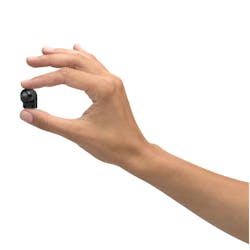Covert Cameras: Now You See It...Soon You Won't
Undercover surveillance is nothing new. Security professionals have hid cameras in all sorts of objects and environments for decades. What is new, however, are the wireless technologies and smaller optics/electronics that are making it easier than ever to get a great picture from a well-placed covert camera. But these advances alone do not necessarily guarantee a successful operation.
When circumstances call for covert camera deployment, you need to carefully assess the environmental challenges to ensure that the video you capture delivers forensic-quality images. Case in point: I was once called by a law enforcement customer very late on a Friday who was having a hard time finding a surreptitious spot for their cameras given the limited covert options at the location. We worked through the issues — field of view, available light, power, etc. — and ended up hiding the cameras inside some sports equipment in the back of an old car and in another inconspicuous location. This effort helped the officers surveil, identify and eventually prosecute a murderer and known drug dealer.
This experience also helped me better understand the challenges that most customers and integrators face when trying to use covert devices in the field.
Off-the Shelf vs. Custom Options
Sometimes law enforcement and the tactical community are able to deploy off-the-shelf covert devices such as height strip poles. Placed at entrances and exits, these embedded covert cameras capture a good, low-level facial shot of suspects focused more on avoiding the cameras overhead that are in plain sight. These pole strip cameras are extremely effective and require modest design consideration due to their typical locations.
More often, however, covert field operations require more customized solutions. For instance, city surveillance might require street corner pole-mounted enclosures. When quickly deployed for crowd control or used in a tactical situation where the cameras might be placed and left for days while the video is collected or an alert is sent to the command center, some sort of wireless connectivity and a long-life battery might be needed.
As it turns out, most major manufacturers of video devices have cameras that can be used very efficiently in covert applications. But many still require additional modification or need to be incorporated into other systems to meet the field conditions. The challenges range from wireless considerations, power issues and heating/cooling constraints to external appearance. They need to subtly blend in with the environment and not look like shiny, bright video devices.
The four keys aspects to look for in a good covert video camera are:
- Optics
- Compression
- Form factor
- Connectors and electronics
Quality Optics Lead to Quality Video
Optics dictate the quality of any covert video. There are a number of elements that comprise that technology.
Zoom capability. In any covert operation, your customers need to zoom in and get enough detail to achieve their objectives. Covert cameras are generally capable of both digital and optical zoom. Optical zoom is the more critical of the two. Generally, 18x zoom at 720p is more than sufficient to identify the target. But needs may differ depending on the covert operation.
Pan/tilt capabilities. The ability to pan and tilt the camera optics enables users to track a target and look at a much wider area from multiple angles.
Low light operations. The camera must be able to see well in dark and low-light situations. A low lux rating of 0.3 for color and 0.005 for black-and-white has been the go-to range for most covert applications. Keep in mind that lux measurements are variable and not a true means of comparison between product vendors as there is no industry standard for measuring light sensitivity. You will not truly know whether the camera is sufficiently light sensitive until you operate the device in actual field conditions. You may find that a product you did not think would work performs better than expected.
Advances in video optics — such as Wide Dynamic Range that can balance shadow and bright light in the same frame and Lightfinder technology that can capture full-color fidelity in extreme low-light conditions — is greatly enhancing image usability and forensic value. But field testing the camera is really the only way to determine whether it will do the job you need.
Advanced Compression
Another key factor to consider is bandwidth and storage. In most covert applications, the cameras are left in remote locations to surveil an area for an extended period of time. They often have very limited wireless connectivity or none at all. Thus, storage and bandwidth are very strategic concerns.
In this case, H.264 compression technology is still the best way to go. With compression savings averaging 60 to 80 percent over MJPEG and 40 to 50 percent over MPEG-4, H.264 provides the best way to pass and store video. Many covert cameras can support high-capacity micro SD cards. With the correct storage settings, it is quite possible to store two weeks or more of video on the camera, depending on the movement in your target environment.
Small Form Factor
With covert video, a small form factor is a must. That can be achieved one of two ways: purchase a miniature covert camera or strip down an overt camera.
What I have found is that many integrators choose an overt camera based on the optics and bandwidth specs. Then, they will modify the camera to fit their particular mounting location or, more typically, a covert enclosure. This usually means removing the base piece for the camera, which makes its profile smaller and easier to fit into a specialized enclosure.
Many will paint the non-optic and non-electronics exterior areas of the camera black because it can camouflage its presence.
The Role of Connectors and Electronics
Another thing to consider when selecting a covert camera has to do with the connectors and the electronics. Since small form factor and limited space for camera deployment are concerns for covert applications, you cannot use a device with bulky external connectors — it will occupy too much space and cause additional restrictions in setup.
If you need to control space in tight quarters, look for a covert camera that allows you to separate the optics by 10-40 feet from the mounting location where the camera body resides. If your application does not afford that luxury, such as when pan and tilt operations are a must, then try to choose devices that have recessed connectors for cables such as RJ-45, and leverage a single PoE cable for both power and remote I/O control.
Powering the covert camera tends to be another issue. Users often try to power too many devices with one common power source and a common set of connectors. I do not pretend to be an expert on electrical engineering for covert applications, or electrical engineering in general; however, thanks to my years of experience working with EEs, I do know that we needed to manage the power correctly across the camera, the wireless device in the “capsule” we devised and the other device(s) the customer may want in the enclosure.
Battery is one powering method the user might choose, but this solution obviously works best in short-term surveillance operations where time limits for power usage are not an issue. For longer-term operations, solar-generated power has proven to be a good alternative when consumption and expectations are calculated properly.
Addressing Privacy
While privacy can be a concern in covert operations, most manufacturers and video management platform vendors have the means to mask video in scenes that cross the threshold into privacy concerns.
Some examples would be in those rare areas where the cameras can view POS transactions, ATMs or entrances and exits to restrooms or fitting rooms. In most cases, however, covert applications are not used to invade privacy, but rather to protect the public, deter criminal behavior and capture those suspected of committing a crime.
A key element of a successful covert operation is to understand and respect the privacy laws of the jurisdiction and deploy and manage the cameras accordingly.
John Bartolac is Manager of Industry Segments and Government Programs for Axis Communications. He has more than 20 years of experience in the security industry. Request more info about Axis by visiting www.securityinfowatch.com/10212966.



